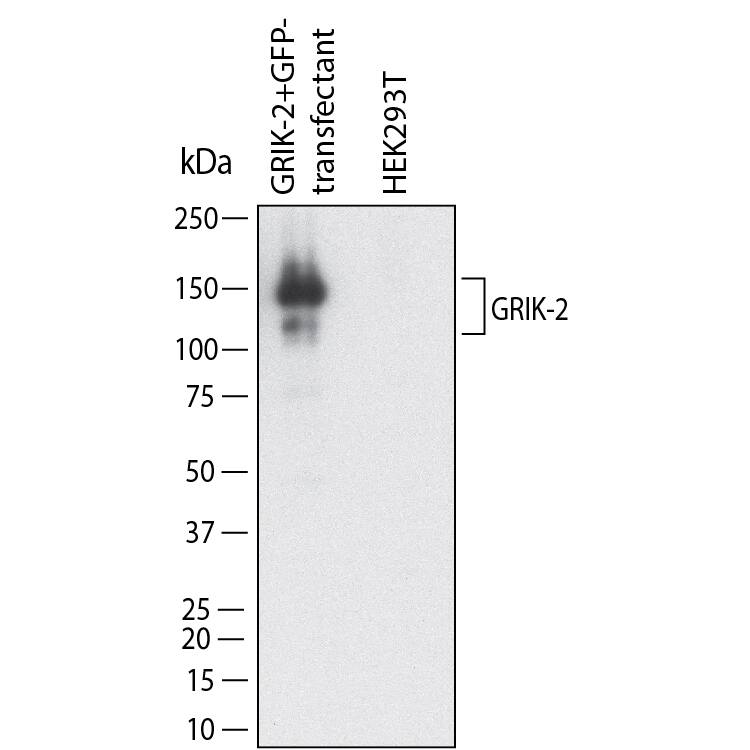Human GluR6/GRIK2 Antibody
R&D Systems, part of Bio-Techne | Catalog # MAB11512

Key Product Details
Species Reactivity
Human
Applications
Western Blot
Label
Unconjugated
Antibody Source
Monoclonal Mouse IgG2B Clone # 1060307
Product Specifications
Immunogen
Chinese Hamster Ovary cell line CHO-derived human GluR6/GRIK2 protein
Thr32-Asn549
Accession # Q13002
Thr32-Asn549
Accession # Q13002
Specificity
Detects recombinant human GluR6/GRIK2 in Western blots.
Clonality
Monoclonal
Host
Mouse
Isotype
IgG2B
Scientific Data Images for Human GluR6/GRIK2 Antibody
Detection of Human GluR6/GRIK2 by Western Blot.
Western Blot shows lysates of HEK293T human embryonic kidney cell line either mock transfected or transfected with human GluR6/GRIK2+GFP. PVDF membrane was probed with 0.5 µg/ml of Mouse Anti-Human GluR6/GRIK2 Monoclonal Antibody (Catalog # MAB11512) followed by HRP-conjugated Anti-Mouse IgG Secondary Antibody (Catalog # HAF018). A specific band was detected for GluR6/GRIK2 at approximately 130 kDa (as indicated). This experiment was conducted under reducing conditions and using Western Blot Buffer Group 1.Applications for Human GluR6/GRIK2 Antibody
Application
Recommended Usage
Western Blot
0.5 µg/mL
Sample: HEK293T human embryonic kidney cell line either mock transfected or transfected with human GluR6/GRIK2+GFP
Sample: HEK293T human embryonic kidney cell line either mock transfected or transfected with human GluR6/GRIK2+GFP
Formulation, Preparation, and Storage
Purification
Protein A or G purified from hybridoma culture supernatant
Reconstitution
Reconstitute at 0.5 mg/mL in sterile PBS. For liquid material, refer to CoA for concentration.
Formulation
Lyophilized from a 0.2 μm filtered solution in PBS with Trehalose. See Certificate of Analysis for details.
*Small pack size (-SP) is supplied either lyophilized or as a 0.2 µm filtered solution in PBS.
*Small pack size (-SP) is supplied either lyophilized or as a 0.2 µm filtered solution in PBS.
Shipping
Lyophilized product is shipped at ambient temperature. Liquid small pack size (-SP) is shipped with polar packs. Upon receipt, store immediately at the temperature recommended below.
Stability & Storage
Use a manual defrost freezer and avoid repeated freeze-thaw cycles.
- 12 months from date of receipt, -20 to -70 °C as supplied.
- 1 month, 2 to 8 °C under sterile conditions after reconstitution.
- 6 months, -20 to -70 °C under sterile conditions after reconstitution.
Background: GluR6/GRIK2
References
- Dingledine, R. et al. (1999) Pharmacol Rev. 51(1):7.
- Traynelis, S.F. et al. (2010) Pharmacol Rev. 62(3):405.
- Contractor, A. et al. (2011) Trends Neurosci. 34(3):154.
- Nanao, M.H. et al. (2005) PNAS 102(5):1708.
- Kumar, J. et al. (2011) Neuron. 71(2):319.
- Fisher, J.L. et al. (2011) J. Neurosci. 31(47):17113.
- Mathew, S.S. and Hablitz, J.J. (2008) Neuropharmacology. 55(1):106.
- Lerma, J. and Marques, J.M. (2013) Neuron. 80(2):292.
- Wu, C.S. et al. (2010) Int J Cancer. 126(11):2542.
- Inoue, R. et al. (2017) Oncotarget. 8(17):28826.
Long Name
Glutamate Receptor 6
Alternate Names
EAA4, GLR6, GluK2, GLUK6, MRT6
Gene Symbol
GRIK2
UniProt
Additional GluR6/GRIK2 Products
Product Documents for Human GluR6/GRIK2 Antibody
Product Specific Notices for Human GluR6/GRIK2 Antibody
For research use only
